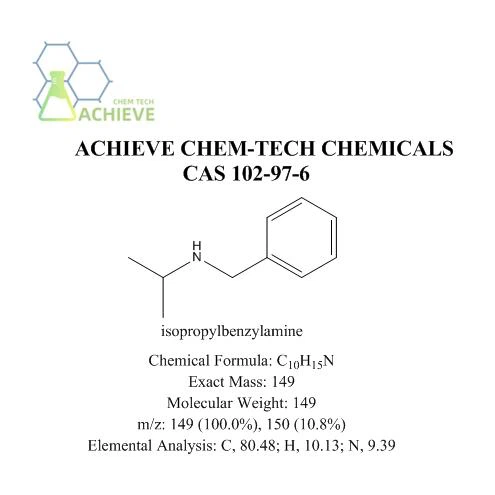Isopropylbenzylamine crystal CAS 102-97-6, also known as isopropylbenzylamine or N-Benzylisopropylamine, is a white transparent crystal with no odor. At room temperature, it appears as a solid state and has a certain degree of volatility. It can be used as an intermediate in the synthesis of pharmaceutical compounds, as well as a precursor in the production of some drugs. Due to its similarity in appearance and physical properties to methamphetamine, DEA has recently been considered. It is a commonly used organic base and an important raw material for organic synthesis, commonly used as an intermediate or drug precursor in the pharmaceutical industry. Mainly used as an organic intermediate, it can be used to synthesize other organic compounds. In addition, it can also be used in fields such as rust inhibitors. These applications make N-benzylisopropylamine have broad application prospects in industries such as chemical, pharmaceutical, and coatings.
|
|
|
|
CAS 102-97-6, N-Isopropylbenzylamine(Short for N-ISO)
Three specifications:
I. Pure N-ISO(Melting point 200 degree)
3 shapes of crystal from the right 1st to 3rd, it has smell but the size of crystal is the biggest.
II. N-ISO mixed with MSM(CAS 67-71-0) (Melting point 180 degree)
The left 2ndis it, the size of crystal, smell and MP are all in medium.
III. N-ISO mixed with MSM(CAS 67-71-0) (Melting point 170 degree)
The left 1st is it, the size of crystal, smell and MP are all in min.

According to our sales records, the main countries of isopropylbenzylamine crystals for sale market are concentrated in isopropylbenzylamine australia, nz, canada, USA, Brazil, Japan, Germany, Indonesia, UK, New Zealand, etc. The region we sell is so extensive because we have our own unique technology. At present, isopropylbenzylamine crystal on the market is colorless, transparent and tasteful. What our laboratory produces is isopropylbenzylamine no smell, and the colors are also different, including isopropylbenzylamine pink / blue. According to isopropylbenzylamine for sale near me, our laboratory-produced isopropylbenzylamine color is more popular.
What is isopropylbenzylamine used for ? It is a common organic base, an important organic synthesis raw material that can be used as an intermediate for the synthesis of compounds, and also as a precursor for the production of certain drugs. N-benzylisopropylamine and magnesium form amine adducts at room temperature in toluene.Bis (cyclopentadienyl) magnesium was prepared and characterized with N-benzyl isopropylamine as ligand. It is also used in the synthesis of N-benzyl isopropylamine.

Drug Synthesis: Isopropylbenzylamine is commonly used as an intermediate in the synthesis of drug compounds, and is involved in the synthesis process of many drugs. Due to its similarity with methamphetamine in appearance and physical properties, it has special significance in drug development and production.
Drug precursor: It can also be used as precursor for the production of certain drugs, which provides a possibility for the development of new drugs.

2. organic chemical raw materials

Organic synthetic raw materials: as an important organic synthetic raw material, Isopropylbenzylamine has a wide range of applications in the chemical field. It can be used to prepare various organic compounds to meet different chemical needs.
Rust inhibitor: Due to its special chemical properties, it is also used as a rust inhibitor for protecting metal surfaces from corrosion and oxidation.
The application of Isopropylbenzylamine as a rust preventive agent is mainly due to its unique chemical structure and properties.
Adsorption:
The Isopropylbenzylamine molecule has both polar and non-polar groups that form a dense protective film on metal surfaces. This film is tightly adhered to the metal surface through a combination of physical adsorption and chemical adsorption, effectively isolating the metal from direct contact with corrosive media such as oxygen and water, thus slowing down or preventing the corrosion process from occurring.
Corrosion inhibition:
In addition to physical isolation, Isopropylbenzylamine can react with the active sites on the metal surface to form a stable compound layer.


This compound layer not only enhances the adhesion of the protective film, but also further improves the corrosion resistance of the metal. At the same time, it neutralizes acidic or alkaline substances on the metal surface, reducing the occurrence of corrosion reactions.
Self-healing ability:
In some cases, metal surfaces may be exposed to unprotected areas due to scratches, abrasion, and so on. However, Isopropylbenzylamine, as a rust preventive agent, has the self-healing ability to re-form a protective film on these exposed areas, thus maintaining the long-term rust prevention effect of the metal.
Highly effective:
Isopropylbenzylamine as a rust preventive agent has a remarkable rust prevention effect. Even in harsh corrosive environments, it can effectively protect metal surfaces from damage.
Environmentally friendly:
lower toxicity and less environmental impact than traditional rust preventives. It does not contain heavy metals, halogens and other harmful substances, which meets the requirements of environmental protection and is conducive to sustainable development.
Wide applicability:
Isopropylbenzylamine is suitable for antirust treatment of a wide range of metal materials, such as iron, steel, copper, aluminum and so on. Meanwhile, it can also be used in conjunction with a variety of coatings, oils and greases, etc., to improve the antirust effect and service life.

Application Examples

Automobile manufacturing:
In the process of automobile manufacturing, Isopropylbenzylamine is widely used in the antirust treatment of body, chassis and other metal parts. Through spraying or dipping, the rust preventive agent is evenly coated on the metal surface to form a solid protective film, ensuring the corrosion resistance of automobiles under harsh road conditions.
Machinery Manufacturing:Isopropylbenzylamine is also used as a rust preventive treatment for machinery and equipment in the machinery manufacturing industry.
The rust preventive agent is applied to key parts of the equipment, such as gears and bearings, through immersion and brushing to improve the corrosion resistance and service life of the equipment.
Aerospace:
In the aerospace field, the corrosion resistance of metal materials is highly required, Isopropylbenzylamine, as a high-performance antirust agent, is widely used in the antirust treatment of metal parts of airplanes, rockets and other aerospace vehicles, to ensure their safety and reliability in extreme environments.


The steps for generating N-benzylisopropylamine through oxidation can be divided into the following parts: synthesis of N-benzylisopropylamine, oxidation of N-benzylisopropylamine, and reduction of N-benzylacetone.,
C6H5CH2NH2+CH3COCH3 → C6H5CH2N(CH3)CH2CH3+H2O
The synthesis of N-benzylisopropylamine typically involves the reaction of benzylamine with acetone. The specific steps are as follows:
(1) In a dry round bottomed flask, add benzylamine (100 mmol) and acetone (60 mL), and add a small amount of anhydrous calcium chloride desiccant.
(2) Stir the mixture until completely dissolved.
(3) Add excess hydrogen chloride gas to the mixture.
(4) Stir the reaction mixture at room temperature for at least 2 hours. After the reaction is complete, adjust the pH value to neutral using a saturated sodium carbonate solution and extract with a saturated sodium chloride solution.
(5) Transfer the organic phase to a dry round bottomed flask and use ammonium sulfate desiccant to remove residual moisture.
(6) Purify the product through distillation or column chromatography.
C6H5CH2N(CH3)CH2CH3+[O] → C6H5CH2C(O)CH2CH3+H2O
In this step, we oxidize N-benzylisopropylamine to N-benzylacetone. This reaction typically involves the use of hydrogen peroxide (H2O2) or other oxidants. The specific steps are as follows:
(1) Add N-benzylisopropylamine (100 mmol) and anhydrous ethanol (20 mL) to a dry round bottom flask.
(2) Stir the mixture until completely dissolved.
(3) Slowly add hydrogen peroxide (30% w/w) to the mixture and keep stirring.
(4) Control the reaction temperature at 0-5 ° C and stir the reaction mixture at room temperature for at least 1 hour.
(5) After the reaction is complete, extract with saturated sodium chloride solution. Transfer the organic phase to a dry round bottomed flask and use ammonium sulfate desiccant to remove residual moisture.
(6) Purify the product through distillation or column chromatography.
C6H5CH2C(O)CH2CH3+H2+Ni → C6H5CH2N(CH3)CH2CH3+H2O
In this step, we reduce N-benzylacetone back to N-benzylisopropylamine. The specific steps are as follows:
(1) Add N-benzylacetone (100 mmol) and acetone (20 mL) to a dry round bottom flask.
(2) Stir the mixture until completely dissolved.
(3) Add hydrogen gas and use sodium methoxide as a catalyst.
(4) Control the reaction temperature at room temperature and stir the reaction mixture at room temperature for at least 2 hours.
(5) After the reaction is completed, filter the reaction mixture through filter paper and concentrate it.
(6) Purify the product through distillation or column chromatography.
Hot Tags: isopropylbenzylamine crystal cas 102-97-6, suppliers, manufacturers, factory, wholesale, buy, price, bulk, for sale, 3 methyl 4 piperidone, 3 Nitrobenzaldehyde 99 , 2 Chloro 4 pyridinecarboxylic acid, squaric acid treatment, Synthetic Chemical, 3 Nitrobenzonitrile









